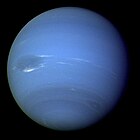قمرهای نپتون

نپتون دارای ۱۴ ماهواره طبیعی شناخته شدهاست، که بزرگترین آن تریتون است که توسط ویلیام لاسل در ده اکتبر ۱۸۴۶ ده روز بعد از کشف خود نپتون کشف شد.
به طور یکتا در میان ماههای سیارههای برزگ تریتون یک ماه بیقاعده محسوب میشود و هم حرکت رجوعی دارد و هم انحرفش نسبت به استوای نپتون زیاد است. ماه بزرگ بعدی که چنین ویژگیهای دارد فوبه است که فقط ۰٫۰۳٪ تریتون جرم دارد. تریتون انقدر بزرگ است که توانسته تعادل هیدرودینامیکی داشته باشد و دمای سطح آن۳۸ کلوین (−۲۳۵٫۲ درجه سلسیوس) است.
فهرست[ویرایش]
| کلید | |||||
|---|---|---|---|---|---|
| ‡ ماههای بیقاعده دارای حرکت معمولی |
♠ ماههای بیقاعده دارای حرکت رجوعی | ||||
این فهرست بر اساس دوره مداری است، از کمترین به بیشترین، ماههای بیقاعده با رنگ مشخص شدهاند
| رتبه [note ۱] |
برچسب [note ۲] |
نام |
تلفظ (کلید) |
تصویر | قطر (km)[note ۳] |
جرم (×۱۰۱۶ کیلوگرم) |
نیمقطر بزرگ (km)[۲] |
تناوب مداری (روز)[۲] |
زاویه انحراف (°)[۲] |
خروج از مرکز مداری [۲] |
سال کشف[۱] |
کاشف [۱] |
|---|---|---|---|---|---|---|---|---|---|---|---|---|
| 1 | Neptune III | نیاد | ˈneɪ. əd | 66 (۹۶ × ۶۰ × 52) |
19 | 48,227 | 0.294 | 4.691 | 0.0003 | 1989 | تیم ویجر | |
| 2 | Neptune IV | تالسا | θəˈlæsə | 82 (۱۰۸ × ۱۰۰ × 52) |
35 | 50,074 | 0.311 | 0.135 | 0.0002 | 1989 | تیم ویجر | |
| 3 | Neptune V | دیسپینا | dɨsˈpi:nə | 150 (۱۸۰ × ۱۴۸ × 128) |
210 | 52,526 | 0.335 | 0.068 | 0.0002 | 1989 | تیم ویجر | |
| 4 | Neptune VI | گلتیا | ˌɡæləˈti:ə |  |
176 (۲۰۴ × ۱۸۴ × 144) |
212 | 61,953 | 0.429 | 0.034 | 0.0001 | 1989 | تیم ویجر |
| 5 | Neptune VII | لاریسا | ləˈrɪsə | 194 (۲۱۶ × ۲۰۴ × 168) |
460 | 73,548 | 0.555 | 0.205 | 0.0014 | 1981 | H. Reitsema, W. Hubbard, L. Lebofsky, and D. J. Tholen | |
| 6 | Neptune VIII | پروتیوس | ˈproʊtiəs |  |
420 (۴۳۶ × ۴۱۶ × 402) |
4,400 | 117,646 | 1.122 | 0.075 | 0.0005 | 1989 | تیم ویجر |
| 7 | Neptune I | تریتون♠ | ˈtraɪtən |  |
2,705.2 ± ۴٫۸ (2,709 × ۲٬۷۰۶ × 2,705) |
2,140,800 ± 5200 |
354,759 | 5.877 | 156.865 | 0.0000 | 1846 | ویلیام لاسل |
| 8 | Neptune II | نیرید‡ | ˈnɪəri:. ɪd |  |
340 ± 50 | 2,700 | 5,513,818 | 360.136 | 7.090 | 0.7507 | 1949 | G.P. Kuiper |
| 9 | Neptune IX | هلیمیدی♠ | ˌhælɨˈmi:di: | ~62 | 16 | 16,611,000 | 1,879.08 | 112.712 | 0.2646 | 2002 | M. Holman, J. Kavelaars, T. Grav, W. Fraser, and D. Milisavljevic | |
| 10 | Neptune XI | سیو‡ | ˈseɪ.oʊ | ~44 | 6 | 22,228,000 | 2,912.72 | 53.483 | 0.1365 | 2002 | M. Holman, J. Kavelaars, T. Grav, W. Fraser, and D. Milisavljevic | |
| 11 | Neptune XII | لیومیدیا‡ | ˌleɪ. ɵmɨˈdi:ə | ~42 | 5 | 23,567,000 | 3,171.33 | 37.874 | 0.3969 | 2002 | M. Holman, J. Kavelaars, T. Grav, W. Fraser, and D. Milisavljevic | |
| 12 | Neptune X | سمتی♠ | ˈsæməθi: | ~40 | 4 | 48,096,000 | 9,074.30 | 126.312 | 0.3809 | 2003 | S.S. Sheppard, D.C. Jewitt, and J. Kleyna | |
| 13 | Neptune XIII | نیسو♠ | ˈni:soʊ | ~60 | 15 | 49,285,000 | 9,740.73 | 136.439 | 0.5714 | 2002 | M. Holman, J. Kavelaars, T. Grav, W. Fraser, and D. Milisavljevic |
یادداشت[ویرایش]
- ↑ رتبه به معنی فاصله از نپتون است
- ↑ برچسب عددهای رومی به معنی ترتیب کشف است.[۱]
- ↑ قطرهایی که به شکل ضرب چند عدد هستند به این معنی است که ماه موردنظر به شکل یک کره نیست و آن اعداد به معنی ابعاد آن ماه در سه بعد است.
منابع[ویرایش]
- ↑ ۱٫۰ ۱٫۱ ۱٫۲ "Planet and Satellite Names and Discoverers". Gazetteer of Planetary Nomenclature. USGS Astrogeology. July 21, 2006. Retrieved 2006-08-06.
- ↑ ۲٫۰ ۲٫۱ ۲٫۲ ۲٫۳ Jacobson, R.A. (2008). "NEP078 – JPL satellite ephemeris". Retrieved October 18, 2010.






